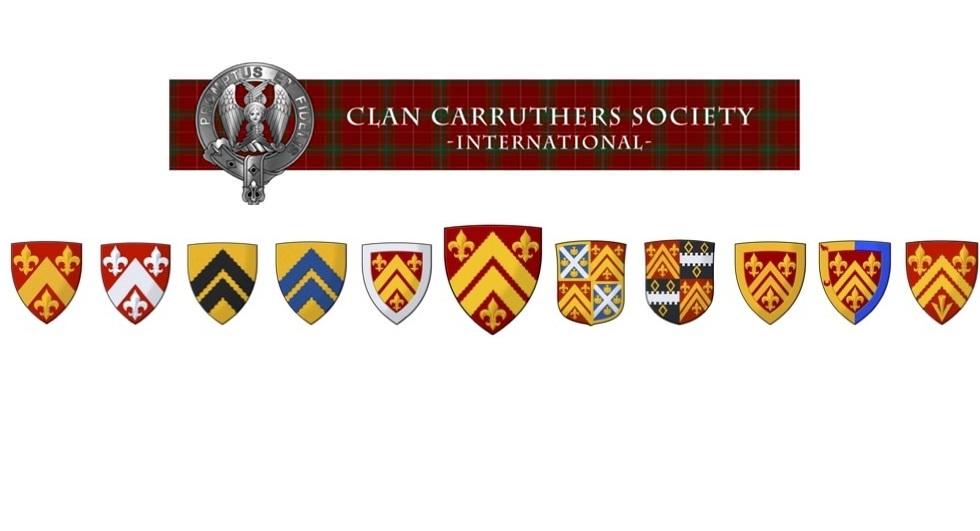
Likes
CARRUTHERS TARTAN
Carruthers right to a Tartan
To understand and appreciate our ability to have a definitive tartan of our own we must first understand its use by families in the borders of Scotland. The history of the use of a clan tartan by Graynes (Reiver families) is definitely not strong. The evidence suggests that if plaid was worn, it was most certainly of a regional pattern rather than specific to a particular family. It is also fair to suggest that kilts would not have been worn, but rather trews (trousers) would have been the order of the day for the reasons alluded to before and of course, because they were widely available as the mode of dress on the borders at the time.
Kilts as we know, were worn in Scotland but were evolved as a highland concept, being taken from the earlier 'brat' or woollen cloak (also known as a plaid), which was worn over a tunic. This earlier cloak or brat may have been plain in colour or in various check or tartan designs, depending on the wealth of the wearer; the earlier fashion of clothing had not changed significantly from that in the highlands since Roman times. This lead to the Breacan an Fhéilidh (belted plaid) or Feileadh Mòr (great plaid) as normally depicted in ancient highland dress. From around the 17th or early 18th century the fèileadh beag (the small kilt), or filibeg, or philabeg, using a single width of cloth worn hanging down below the belt came into use. It become popular throughout the Highlands and northern Lowlands by around mid 1700's, although the great kilt or belted plaid continued to be worn by the highland clans. In a modern world most Scottish clans/families enjoy wearing the kilt, irrelevant of their region of birth and there is no reason why they shouldn't. It gives a feeling of national pride and anchorage in the customs and traditions of all things Scottish, where the heritage of our homeland remains important us all, wherever they hail. Clan Carruthers should be of no exception.
Saying all this, here are two pieces from the (STA) Scottish Tartan Authority's website for your deliberation:
It has to be remembered that, in the present context, tartan is Highland and that the Lowlands did not adopt it in the 'family' sense, to any large extent, until the mid-eighteenth century, when the Lowland tartan industry had begun to grow up as a result of the 1747 Act which sought to abolish tartan altogether. My recent research into military tartans suggests strongly that the blue, black and green tartans owe their existence to military fashion or even War Department ruling: this is not to say that all such tartans are military ones but that the army started the idea. The other class of dark tartans, those known as 'hunting', almost certainly derive jointly from a rather obscure statement by George Buchanan (see the right hand column) and the strident colours of the early synthetic dyes. A third class, many-hued, comprises the Sobieski confections, which are either inventions or minor modifications of established tartans of their time.
http://www.tartansauthority.com/tartan/the-growth-of-tartan/the-origin-of-clan-tartans/
Link: http://www.tartansauthority.com/tartan/the-growth-of-tartan/the-origin-of-clan-tartans/
It is perfectly possible that individual Lowland families were adopting favourite patterns which became identified with them, later to become their "clan tartans". Is it reasonable to expect those clan tartans to be identical to the ones of the same names which we know today?
http://www.tartansauthority.com/tartan/the-growth-of-tartan/the-origin-of-clan-tartans/a-case-for-clan-tartans/
Link: http://www.tartansauthority.com/tartan/the-growth-of-tartan/the-origin-of-clan-tartans/a-case-for-clan-tartans/
Therefore with the resurgence in all things Scottish and Scottish families redefining and registering themselves as Clans and with their Chiefs being accepted onto the Standing Council of Chiefs, a tartan of our own seemed the next logical and identifiable step along the road to an international Carruthers Clan Society, which was set up in 2017. It is fair to say, that any clan is defined, in the eyes of the public by the three ; they are its distinct tartan, its clan arms and badge and its history. As a family entity we now have all three from which to progress to clan status if we so chose.
Although we would still retain the right to wear Bruce, in 2017, Dr George Carruthers, a Fifer by birth registered a Carruthers tartan, designed by Brian Wilton, with the Scottish Tartan Register. The tartan followed the Bruce sett (pattern) and thread count with variations in the thread colours and subtle changes in the sett itself in order to differentiate it and allow the design to be accepted as unique to the ancients, honourable and distinct Clan Carruthers, wherever they may hail.
SRT No. 11700. Designer: Wilton, Brian Tartan date: 01/12/2016 Registration date: 25 January 2017 Category: Name Restrictions: Registration notes: A dress version of the George Carruthers (Personal) tartan (STR ref. 11699). This tartan can be used by others bearing the Carruthers surname.


